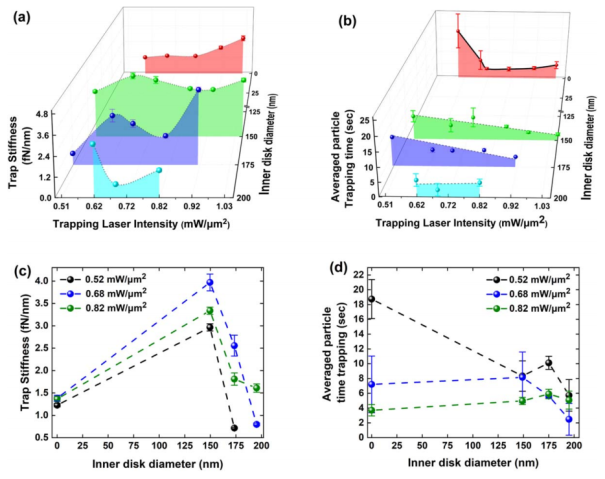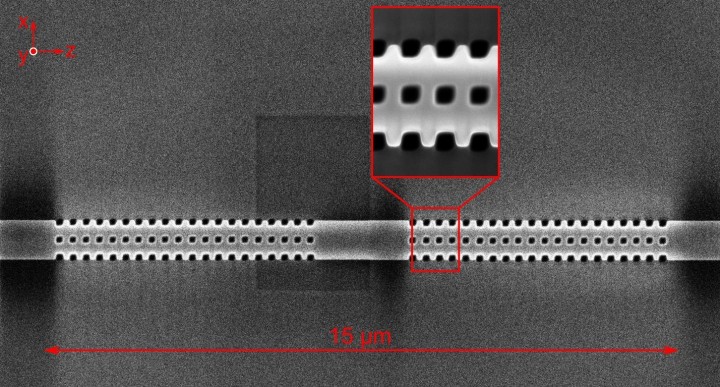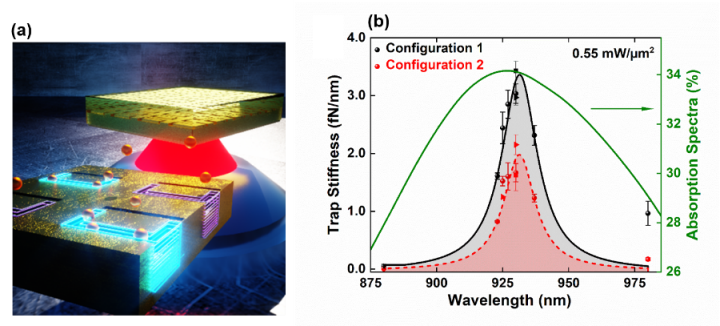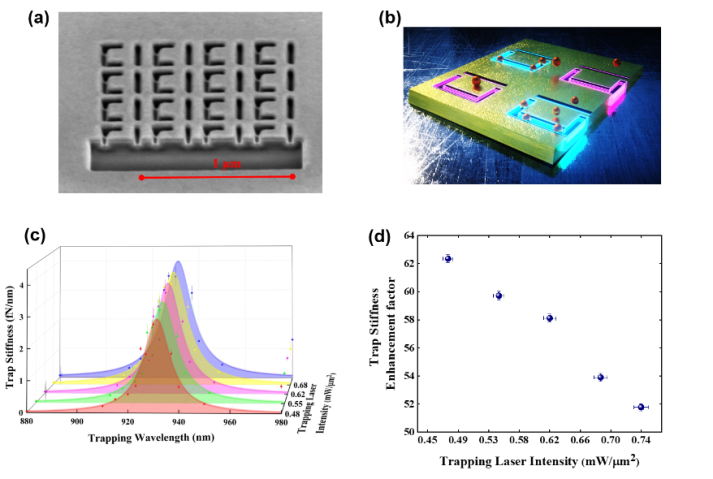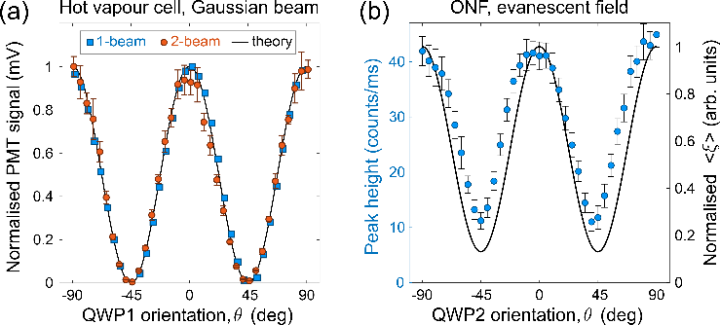FY2020 Annual Report
Light-Matter Interactions for Quantum Technologies Unit

Abstract
FY2020 was a very difficult year due the pandemic, putting a stop to many of our collaborative projects and leading to many difficulties in bringing researchers to OIST. Despite this, we were able to work almost the entire year in our laboratories (apart from 3 weeks of lockdown) and we produced many exciting results on our nanofibre applictions work in cold atoms and for particle manipulation. We explored novel materials for whispering gallery lasers with out collaboators from Harbin, China. We also progressed extremely well in the trapping of the "very small" using plasmonic metamaterial devices designed in-house. While a quieter year in many respects than previous years, since COVID19 struck and we had to curtail all visitors to OIST and all travel from OIST, our work was still progressing well with the limitations this brought. Our major research outputs are discussed below and included the completion of two PhD theses in the unit. We also continued to contribute to outreach activities online through the OSA and SPIE, particularly through their lecturer programmes.
1. Staff
Research Staff
- Dr. Dylan Brown, Postdoctoral Scholar (from July 2020, onsite in December 2020)
- Dr. Jesse Everett, Postdoctoral Scholar
- Dr. Vandna Gokhroo, Staff Scientist (until March 2021)
- Dr. Jameesh Keloth, Postdoctoral Scholar (from September 2019)
- Dr. Domna Kotsifaki, Staff Scientist
- Dr. Shilong Li, Staff Scientist (from October 2020, onsite in January 2021)
- Dr. Priscila Romagnoli, Postdoctoral Scholar (until August 2020)
- Dr. Ke Tian, Postdoctoral Scholar
- Dr. Georgiy Tkachenko, JSPS Fellow (until December 2020), Staff Scientist (from January 2021)
- Dr. Viet Giang Truong, Group Leader/Staff Scientist
- Dr. Jonathan Ward, Staff Scientist (until April 2020)
Support Staff
- Dr. Kristoffer Karlsson, Technician
- Emi Nakamura, Research Unit Administrator
- Metin Ozer, Technician
PhD Students
- Theodoros Bouloumis, OIST PhD student
- Cindy Esporlas, OIST PhD student
- Ratnesh Kumar Gupta, OIST PhD student
- Maki Maeda, OIST PhD student
- Krishnapriya Subramonian Rajasree, OIST PhD student (until February 2021)
- Christina Ripken, OIST PhD student (co-supervision) (until November 2020)
- Lewis Ruks, OIST PhD student (co-supervision)
- Zohreh Shahrabifarahani, OIST PhD student (from January 2021)
- Alexey Vylegzhanin, OIST PhD student (from January 2021)
Visiting Researchers
- Dr. Isha Sankskriti (April 2020-January 2021)
Rotation/Intern Students/Visiting Research Student
- Tai Tran, Rotation Student (January-April 2020)
- Irina Korshok, Rotation Student (May-August 2020)
- Alexey Vylegzhanin, Rotation Student (May-August 2020)
- Kang-Yu Chu, Rotation Student (September-December 2020)
- Maria Carla Lupa, Rotation Student (September-December 2020)
- Prajakta Kokate, Rotation Student (January-April 2021)
- Aswathy Raj, Rotation Student (January-April 2021)
- Alexey Vylegzhanin, Independent Study on Basics of Laser Cooling (September-December 2020)
- René Henke, DAAD Fellow, Visiting Research Student, Universität Münster, Germany (April 2019 – August 2020)
- Jibo Yu, Visiting Research Student, Harbin Engineering University China (September 2019 – September 2020)
- Angzhen Li, Visiting Research Student, Harbin Engineering University, China (October 2019 – October 2020)
- Konosuke Shimazaki, Visiting Research Student, Kyoto University, Japan (March 2021)
- Zohreh Shahrabifarahani, Research Intern, Iran (October-April 2020) (PhD student OIST)
- Soma Mishra, Research Intern, BITS Pilani, India (October-April 2020) (PhD student OIST)
- Jaime Rivera, Research Intern, University of the Philippines, Philippines (June-September 2020)
- Ayushman Tripathi, Research Intern, The University of the Ryukyus, Japan (February-March 2021)
2. Collaborations
- Theme: Transverse spin effects
- Type of collaboration: Joint research
- Researchers:
- M. Petrov (ITMO, Russia)
- Theme: Multiphoton processes mediated via nanofibres
- Type of collaboration: Joint research
- Researchers:
- T. Ray (Universite Sorbonne, France)
- Theme: Blue comb using WGM resonators
- Type of collaboration: Joint research
- Researchers:
- F. Lei (Chalmers University, Sweden)
- J. Ward (UCC, Ireland)
- Theme: Nanoparticle trapping using novel optical fibres
- Type of collaboration: Joint research
- Researchers:
- J. Fick (Institut Neel, France)
- H. Giessen (University of Stuttgart, France)
- S. Mondal (CSIO, India)
- Theme: Rydberg atoms and optical nanofibres
- Type of collaboration: Joint research
- Researchers:
- E. Brion (University of Toulouse, France)
- J. Robert (ENS Paris Saclay, France)
- K. Moelmer (Aarhus University, Denmark)
- Theme: Nonlinear materials for WGM resonators
- Type of collaboration: Joint research
- Researchers:
- P. Wang (Harbin Engineering University, China)
- P. Wang (Harbin Engineering University, China)
- Theme: WGM-based photothermal imaging
- Type of collaboration: Joint research
- Researchers:
- R. Goldsmith (University of Wisconsin, Madison, USA)
- Theme: Fiber antennas for optical coupling
- Type of collaboration: Joint research
- Researchers:
- S. Mondal (CSIO Chandigarh, India)
- J. Fick (Institut Neel, France)
- Theme: Microbubbles for phase changes
- Type of collaboration: Joint research
- Researchers:
- T. Carmon (Technion, Israel)
- Theme: Microbubbles for sensing applications
- Type of collaboration: Joint research
- Researchers:
- F. Vollmer (University of Exeter, UK)
- Theme: Neutral atoms and optical nanofibres
- Type of collaboration: Joint research
- Researchers:
- T. Busch and F. Le Kien (Quantum Systems Unit, OIST)
3. Activities and Findings
3.1 Fast and efficient nanoparticle trapping using plasmonic connected nanoring apertures
The manipulation of microparticles using optical forces has led to many applications in the life and physical sciences. To extend optical trapping towards the nanoregime, in this work we demonstrated trapping of single nanoparticles in arrays of plasmonic coaxial nano-apertures with various inner disk sizes and theoretically estimated the associated forces. A high normalised experimental trap stiffness of 3.50 fN nm−1 mW−1 μm−2 for 20 nm polystyrene particles was observed for an optimum design of 149 nm for the nanodisk diameter at a trapping wavelength of 980 nm. Theoretical simulations were used to interpret the enhancement of the observed trap stiffness. A quick particle trapping time of less than 8 s was obtained at a concentration of 14 × 1011 particles ml−1 with low incident laser intensity of 0.59 mW μm−2. This good trapping performance with fast delivery of nanoparticles to multiple trapping sites emerged from a combination of the enhanced electromagnetic near-field and spatial temperature increase. This work has applications in nanoparticle delivery and trapping with high accuracy, and bridges the gap between optical manipulation and nanofluidics.
Figure: (a) Trap stiffness for a 20 nm PS particle as a function of incident laser intensity and inner disk diameter. The dotted lines serve as visual aids. (b) Average particle trapping time as a function of trapping laser intensity and inner disk diameter. The black solid line for 0 nm inner disk diameter serves as a visual aid while the dashed lines are linear fits to the experimental results. Each color represents a different disk diameter. (c) Trap stiffness and (d) average time to trap a particle as a function of inner disk diameter for 0.52, 0.68, and 0.82 mW μm−2 incident laser intensities. The points plotted are averaged values over three trapping events for different laser intensities (different colors), along with their standard deviations.
Publication:
Fast and efficient nanoparticle trapping using plasmonic connected nanoring apertures
TD Bouloumis, DG Kotsifaki, X Han, S Nic Chormaic and VG Truong
Nanotechnology 32, 025507 (2021)
3.2 Fabrication of optical nanofibre-based cavities using focussed ion-beam milling
Nanofibre-based optical cavities are particularly useful for quantum optics applications, such as the development of integrated single-photon sources, and for studying fundamental light-matter interactions in cavity quantum electrodynamics (cQED). Several techniques have been used to produce such cavities, including focussed ion beam (FIB) milling, where it can be used for the fabrication of complex structures directly in the nanofibre. However, it is challenging to mill insulating materials with highly-curved structures and large aspect ratios, such as silica nanofibres, due to charge accumulation in the material. In this article, we highlighted the main features of nanofibres and briefly review cQED with nanofibre-based optical cavities. An overview of the milling process was given with a summary of different FIB milled devices and their applications. Finally, our technique to produce nanofibre cavities by FIB milling is presented. To overcome these challenges, we specially designed a base plate with an indium tin oxide (ITO)-coated Si substrate and outline our procedure, which improves stability during milling and increases repeatability.
Publication:
Fabrication of optical nanofibre-based cavities using focussed ion-beam milling - A review
P Romagnoli, M Maeda, JM Ward, VG Truong and S Nic Chormaic
Appl. Phys. B 126, 111 (2020)
3.3 A tellurite glass optical microbubble resonator
We presented a method for making microbubble whispering gallery resonators (WGRs) from tellurite using a CO2 laser. The customized fabrication process permitted us to process glasses with low melting points into microbubbles with loaded quality factors as 2.3×106. The advantage of soft glasses is that they provide a wide range of refractive index, thermo-optical, and optomechanical properties. The microbubbles fabricated using this method have a low eccentricity and uniform wall thickness, as determined from electron microscope images and the optical spectra. The compound glass microbubbles have the potential for a wide range of applications, including sensing, nonlinear optics, tunable microcavity lasers, and integrated photonics.
Fig. 1. (a-c) Three step fabrication processes for the tellurite glass microbubble. (d-f) Microscope images of the tellurite glass capillary, microsphere, and microbubble in steps (a-c). (g) SEM image of a broken tellurite glass microbubble, the wall thickness at position B being 670 nm. (h) The measured thickness at the different positions in (g).
Publication:
A tellurite glass optical microbubble resonator
J Yu, J Zhang, R Wang, A Li, M Zhang, S Wang, P Wang, JM Ward and S Nic Chormaic
Opt. Express 28, 32858 (2020) Editor's Pick
3.4 Dynamic multiple nanoparticle trapping using metamaterial plasmonic tweezers
Optical manipulation has attracted remarkable interest owing to its versatile and non-invasive nature. However, conventional optical trapping remains inefficient for the nanoscopic world. The emergence of plasmonics in recent years has brought a revolutionary change in overcoming limitations due to diffraction and the requirements for high trapping laser powers. Among the near-field optical trapping cavity-based systems, Fano resonant optical tweezers have a robust trapping capability. In this work, we have experimentally demonstrated sequential trapping of 20 nm particles through the use of metamaterial plasmonic optical tweezers. We have investigated the multiple trapping via trap stiffness measurements for various trapping configurations at low and high incident laser intensities. Our results have provided an alternative approach to trap multiple nanoparticles at distinct hotspots, enabling ways to control mass transport on the nanoscale.
Figure: (a) Schematic illustration of 20 nm particle optical trapping using plasmonic optical tweezers, (b) Absorption spectra (green line) and trap stiffness versus trapping wavelength and trapping positions for a laser intensity of 0.55 mW/μm2. The red and black lines are Lorentz fit result from the experimental data.
Publication:
Dynamic multiple nanoparticle trapping using metamaterial plasmonic tweezers
DG Kotsifaki, VG Truong and S Nic Chormaic
Appl. Phys. Lett. 118, 021107 (2021)
3.5 Fano-resonant, asymmetric, metamaterial-assisted tweezers for single nanoparticle trapping
Plasmonic nanostructures overcome Abbe's diffraction limit to create strong gradient electric fields, enabling efficient optical trapping of nanoparticles. However, it remains challenging to achieve stable trapping with low incident laser intensity. Here, we have demonstrated a Fano resonance-assisted plasmonic optical tweezers for single nanoparticle trapping in an array of asymmetrical split nano-apertures on a 50 nm gold thin film. A large normalized trap stiffness of 8.65 fN/nm/mW for 20 nm polystyrene particles at a near-resonance trapping wavelength of 930 nm was achieved. The trap stiffness on-resonance is enhanced by a factor of 63 compared to off-resonance due to the ultrasmall mode volume, enabling large near-field strengths and a cavity Purcell effect contribution. These results facilitate trapping with low incident laser intensity, thereby providing new options for studying transition paths of single molecules such as proteins.
Figure: (a) Scanning electron microscope image of 4x4 asymmetric split-ring metamolecules at an angle of 52o from the surface normal, (b) Schematic of a single 20 nm polystyrene particle trapping using the metamaterial structure, (c) Trap stiffness of a single nanoparticle as a function of trap intensity and wavelength, (d) Trap stiffness enhancement factor as a function of incident trapping laser intensity.
Publication:
Fano-resonant, asymmetric, metamaterial-assisted tweezers for single nanoparticle trapping
DG Kotsifaki, VG Truong and S Nic Chormaic
Nano Lett. 20, 3388 (2020)
3.6 Analysis of small microplastics in coastal surface water samples of the subtropical island of Okinawa, Japan
We analysed the small microplastics found in costal surface water samples of Okinawa, Japan. This subtropical island is the largest island in the Ryukyu Islands Arc. Marine plastic debris is widely recognised as a global environmental issue, even for such a remote island as Okinawa. We looked at plastics with an upper size limit of 20 μm. These small microplastics have been identified as having the highest potential for causing damage to marine ecosystems. Using an optical micro-Raman tweezers setup, we have identified the composition of particles trapped in marine aggregates collected from the coastal surface waters around the subtropical island of Okinawa. Chemical composition analysis at the single-particle level indicates dominance by low-density polyethylene, which accounted for 75% of the small microplastics analysed. The smallest microplastics identified were (2.53 ± 0.85) μm polystyrene. Our results show the occurrence of plastics at all test sites, with the highest concentration in areas with high human activities. This is the first time this method as been used on environmental samples.
Figure: (a) Percentage composition of all particles. (b) The black line indicates the Raman spectrum of polystyrene (PS) and the blue line of polypropylene (PP) found at Nago (S8) and Nakagusku (S2) areas, respectively. (c) Average diameter of small microplastics where n indicates the number of polymers.
Publication:
Analysis of small microplastics in coastal surface water samples of the subtropical island of Okinawa, Japan
C Ripken, S Nic Chormaic and DG Kotsifaki
Sci. Total Environ. 760, 143927 (2021)
3.7 Observation of the 87Rb 5S1/2 to 4D3/2 electric quadrupole transition at 516.6 nm mediated via an optical nanofiber
Quadrupole transitions play an important role in atomic and molecular spectroscopy and can be useful for angular momentum transfer from light to atoms and high precision measurements of parity non-conservation. Compared with the dipole transition where the transition strength is proportional to the dipole moment of the atom and the electric field of the light, the transition strength for the quadrupole transition is proportional to the electric quadrupole moment of the atom and the gradient of the light field. Due to the gradient dependency, quadrupole transitions are less studied as it can be challenging to create a large enough field gradient experimentally.
We reported on the observation of evanescent field assisted electric quadrupole transition in laser-cooled 87Rb atoms using only few micro-watt of laser powers propagating through an optical nanofibre embedded in the cold atom cloud. We demonstrated electric quadrupole excitation for different powers of 516.6nm power propagating through the nanofibre. We extracted effective quadrupole Rabi frequency, which is a measure of quadrupole transition strength, for each power and peak in the spectra. We found a good qualitative agreement between the experimentally measured and theoretical estimated value of effective Rabi frequency.
Our work extends the use of optical nanofibres in atomic system and could find applications in the atomic clocks and high precision measurement studies of parity violation with rubidium atoms.
Figure: Quadrupole transition signal in 87Rb for the 5S1/2 ground state to the 4D3/2 excited states using 516.6 nm light through the ONF. (a) The 795 nm signal measured at the SPCM as a function of the 516.6 nm frequency for different powers in the ONF; The relative frequency is defined as the atomic transition frequency for 5S1/2 F = 2 -> 4D3/2 F' = 3 minus the laser frequency (b) photon count under the peak for the first three transitions, plotted against propagating power scaled to the fitted value of Ωeff . Power is measured at the output pigtail of the ONF.
Publication:
Observation of the 87Rb 5S1/2 to 4D3/2 electric quadrupole transition at 516.6 nm mediated via an optical nanofibre
T Ray, RK Gupta, V Gokhroo, JL Everett, T Nieddu, KS Rajasree and S Nic Chormaic
New J. Phys. 22, 062001 (2020) Fast Track Communication
3.8 Spin selection in single-frequency two-photon excitation of alkali-metal atoms
In this work, we study the 5S1/2 → 6S1/2 transition in 87Rb, which is electric dipole forbidden. This study addresses two questions: (i) how does the rate of the two-photon transition depend on the polarisation of the excitation light? and (ii) how does this apply to excitation in a vapor cell with Gaussian beam illumination, and laser-cooled atoms in the evanescent field of a single-mode ONF, where the light is strongly nonparaxial. A theoretical framework for spin selection in single-frequency, two-photon excitation of alkali-metal atoms as a function of polarisation of the excitation light is developed. The experiments showed that the rate of a two-photon transition between S levels in atomic rubidium follows a simple quadratic dependence on the helicity parameter of the excitation light. The transition is forbidden (that is, it has a rate of zero) under circularly polarised paraxial excitation, in accordance with the selection rule for the spin angular momentum. By contrast, when the excitation is realised via the evanescent field of nanowaveguide, the transition cannot be completely extinguished by only varying the polarisation.
Polarization dependence of the two-photon transition rate. Solid line: simulation.
Publication:
Spin selection in single-frequency two-photon excitation of alkali-metal atoms
KS Rajasree, RK Gupta, V Gokhroo, F Le Kien, T Nieddu, T Ray, S Nic Chormaic and G Tkachenko
Phys. Rev. Res. 2, 033341 (2020)
4. Publications
4.1 Journals
- Haro, M., Kumar, P., Zhao, J., Koutsogiannis, P., Porkovich, AJ, Ziadi, Z, Bouloumis, T, Singh, V., Juarez-Perez, EJ., Toulkeridou, E., Nordlund, K., Djurabekova, F., Sowwan, M. and Grammatikopoulos, P. Nano-vault architecture mitigates stress in silicon-based anodes for lithium-ion batteries. Comms. Mater. 2, 16, doi: https://doi.org/10.1038/s43246-021-00119-0 (2021)
- Minz, RA., Tiwari, U., Kumar, A., Nic Chormaic, S., Lahlil, K., Gacoin, T., Mondal SK. and Fick, J. Trapping of rare earth-doped nanorods using quasi Bessel beam optical fiber tweezers*. OSA Continuum 4, 364, doi: https://doi.org/10.1364/OSAC.417151 (2021) Editor's Pick
- Kotsifaki, DG., Truong, VG. and Nic Chormaic, S. Dynamic multiple nanoparticle trapping using metamaterial plasmonic tweezers. Appl. Phys. Lett. 118, 021107, doi: https://doi.org/10.1063/5.0032846 (2021).
- Ripken, C., Nic Chormaic, S. and Kotsifaki, DG. Analysis of small microplastics in coastal surface water samples of the subtropical island of Okinawa, Japan. Sci. Total Environ. 760, 143927, doi: https://doi.org/10.1016/j.scitotenv.2020.143927 (2021).
- Kien, F.L., Ruks, L., Nic Chormaic, S. and Busch, T. Coupling between guided modes of two parallel nanofibers. New J. Phys. 22, 123007, doi: https://doi.org/10.1088/1367-2630/abc8af (2020).
- Ripken, C., Shoguchi, E. and Khalturin, K. Response of coral reef dinoflagellates to nanoplastics under experimental conditions. Microorganisms 8, 1759, doi: https://doi.org/10.3390/microorganisms8111759 (2020).
- Yu, J., Zhang, J., Wang, R., Li, A., Zhang, M., Wang, S., Wang, P., Ward, JM. and Nic Chormaic, S. A tellurite glass optical microbubble resonator. Opt. Express 28, 32858, doi: https://doi.org/10.1364/OE.406256 (2020) Editor's Pick.
- Bouloumis, TD., Kotsifaki, DG., Han, X., Nic Chormaic, S. and Truong, VG. Fast and efficient nanoparticle trapping using plasmonic connected nanoring apertures. Nanotechnology 32, 025507, doi: https://doi.org/10.1088/1361-6528/abbca9 (2020).
- Rajasree, K.S., Gupta, RK., Gokhroo, V., Kien, F.L., Nieddu, T., Ray, T., Nic Chormaic, S. and Tkachenko, G. Spin selection in single-frequency two-photon excitation of alkali-metal atoms. Phys. Rev. Res. 2, 033341, doi: https://doi.org/10.1103/PhysRevResearch.2.033341 (2020).
- Tkachenko, G., Toftul, I., Truong, VG. and Nic Chormaic, S. Orbiting of dielectric particles around a single-mode ultrathin fiber waveguide. Proc. SPIE 11522, Optical Manipulation and Structured Materials Conference 2020, 115220F, doi: https://doi.org/10.1117/12.2573514 (2020).
- Ray, T., Gupta, RK., Gokhroo, V., Everett, JL., Nieddu, T., Rajasree, K.S. and Nic Chormaic, S. Observation of the 87Rb 5S1/2 to 4D3/2 electric quadrupole transition at 516.6 nm mediated via an optical nanofiber. New J. Phys. 22, 062001, doi: https://doi.org/10.1088/1367-2630/ab8265 (2020) Fast Track Communication.
- Kien, F.L., Nic Chormaic, S. and Busch, T. Chiral excitation of a single atom by a quantized single-photon pulse in a guided mode of a nanofiber. Phys. Rev. A 101, 063816, doi: https://doi.org/10.1103/PhysRevA.101.063816 (2020).
- Romagnoli, P., Maeda, M., Ward, JM., Truong, VG. and Nic Chormaic, S. Fabrication of optical nanofibre-based cavities using focussed ion-beam milling - A review. Appl. Phys. B 126, 111, doi: https://doi.org/10.1007/s00340-020-07456-x (2020).
- Kotsifaki, DG., Truong, VG. and Nic Chormaic, S. Fano-resonant, asymmetric, metamaterial-assisted tweezers for single nanoparticle trapping. Nano Lett. 20, 3388, doi: https://doi.org/10.1021/acs.nanolett.0c00300 (2020).
- Stourm, E., Lepers, M., Robert, J., Nic Chormaic, S., Mølmer, K. and Brion, E. Spontaneous emission and energy shifts of a Rydberg rubidium atom close to an optical nanofiber*. Phys. Rev. A 101, 052508, doi: https://doi.org/10.1103/PhysRevA.101.052508 (2020).
- Kumar, A., Kim, J., Lahlil, K., Julie, G., Nic Chormaic, S., Kim, J., Gacoin, T. and Fick, J. Optical trapping and orientation-resolved spectroscopy of europium-doped nanorods*. J. Phys. Photonics 2, 025007, doi: https://doi.org/10.1088/2515-7647/ab83e3 (2020).
- Kumar, A., Kim, J., Nic Chormaic, S., Kim, J., Gacoin, T. and Fick, J. Direction and polarization resolved spectroscopic investigation of optically trapped europium-doped nanorods*. Proc. SPIE 11345, Nanophotonics VIII, 113452U, doi: https://doi.org/10.1117/12.2560328 (2020).
- Yu, J., Wang, X., Li, W., Zhang, M., Zhang, J., Nic Chormaic, S. and Wang, P. An experimental and theoretical investigation of a 2 µm wavelength low-threshold microsphere laser*. J. Light. Technol. 38, 1880, doi: https://doi.org/ 10.1109/JLT.2019.2958349 (2020).
*main work done outside OIST
4.2 PhD Thesis
- Subramonian Rajasree, K. Rydberg excitation and other multiphoton processes in cold rubidum atoms near an optical nanofiber. OIST Graduate University, Japan (2020)
- Ripken, C. Micro- and nanoplastics in Okinawa - Potential impacts on planktonic microalgae and endosymbiotic dinoflagellates. OIST Graduate University, Japan (2020)
4.3 Books and other one-time publications
Nothing to report
4.4 Oral and Poster Presentations
- Kotsifaki, DG., Truong, VG., Nic Chormaic, S. Fano resonant-assisted optical tweezers for dynamic multiple nanoparticle trapping (contributed talk): The 68the JSAP Spring Meeting 2021 Online Meeting, Japan, 18 March (2021).
- Nic Chormaic, S. Nonlinear optics and sensing using WGM resonators (invited talk): Photonics West 2021 Digital Forum, USA, 6 March (2021).
- Kotsifaki, DG., Truong, VG. and Nic Chormaic, S. Giant optical forces using an array of asymmetric split-ring plasmonic nanostructures (contributed talk): Photonics West 2021 Digital Forum, USA, 6 March (2021).
- Bouloumis, TD., Kotsifaki, DG., Han, X., Nic Chormaic, S. and Truong, VG. Optimization of plasmonic nanoring array structures for 20-nm particle trapping (contributed talk): Photonics West 2021 Digital Forum, USA, 6 March (2021).
- Nic Chormaic, S. Ultrathin optical fibres and whispering gallery resonators - basics, particle trapping and beyond (online keynote talk): ICAMCM-2021, Jaipur, India, 19 February (2021).
- Nic Chormaic, S. Optical nanofibre mediated evanescent field interactions with cold rubidium atoms (online invited talk): NCTS Annual Meeting on Quantum Science and Technology, National Tsing Hua University, Taiwan, 18 February (2021).
- Gokhroo, V., Gupta, RK., Everett, JL., Rajasree, K.S. and Nic Chormaic, S. Electric quadrupole excitation in laser-cooled 87Rb atoms near an optical nanofibre (online contributed talk): NCTS Annual Meeting on Quantum Science and Technology, National Tsing Hua University, Taiwan, 18 February (2021).
- Tkachenko, G., Toftul, I., Esporlas, C., Truong, VG., Petrov, MI. and Nic Chormaic, S. Near-field optomechanics with nanofiber waveguides (online contributed talk): NCTS Annual Meeting on Quantum Science and Technology, National Tsing Hua University, Taiwan, 18 February (2021).
- Gupta, RK., Everett, JL., Gokhroo, V. and Nic Chormaic, S. Machine optimization of evanescent field trap for Rb atoms (online contributed talk): NCTS Annual Meeting on Quantum Science and Technology, National Tsing Hua University, Taiwan, 18 February (2021).
- Nic Chormaic, S. Ultrathin optical fiber applications from atomic physics through quantum optics (online invited talk): Quantum Sensors of Magnetic and Intertial Forces, OIST Mini-Symposium, Okinawa, Japan, 08 February (2021).
- Nic Chormaic, S. Probing and manipulating cold atoms using evanescent fields of optical nanofibres (invited talk): Tohuku Quantum Alliance x OIST Virtual Quantum Meeting, Japan, 24 November (2020).
- Kotsifaki, DG., Truong, VG. and Nic Chormaic, S. Strong nanoparticle trapping using an array of asymmetrically-split ring nanostructures (contributed talk): OPJ 2020 Online Conference, 16 November (2020).
- Tkachenko, G., Toftul, I., Truong, VG., Petrov, MI. and Nic Chormaic, S. Optomechanics with single-mode optical nanofibers (contributed talk): OSJ-OSA-OSK Joint Symposia on Optics, OPJ 2020 Online Conference, 14 November (2020).
- Gupta, RK., Rajasree, K.S., Everett, JL., Gokhroo, V., Karlsson, K., Tkachenko, G., Kien, F.L. and Nic Chormaic, S. Multiphoton processes in cold rubidium atoms using optical nanofibers (invited talk): OSJ-OSA-OSK Joint Symposia on Optics, OPJ 2020 Online Conference, 14 November (2020).
- Kotsifaki, DG., Truong, VG. and Nic Chormaic, S. Plasmonic optical tweezers based on metamaterial (contributed talk): Women in Photonics 2020 Virtual Workshop, 30 October (2020).
- Stourm, E., Lepers, M., Robert, J., Nic Chormaic, S., Mølmer, K. and Brion, E. Spontaneous emission rates and energy shifts of a Rydberg rubidium atom close to an optical nanofiber (contributed talk): OSA Quantum 2.0 Online Conference, 17 September (2020).
- Bouloumis, TD., Kotsifaki, DG., Truong, VG. and Nic Chormaic, S. Metamaterial tweezers for enhanced nanoparticle trapping (contributed talk): METANANO 2020 Online, 17 September (2020).
- Tkachenko, G., Toftul, I., Truong, VG., Petrov, M. and Nic Chormaic, S. Optomechanics with single-mode optical nanofibers (invited talk): METANANO 2020 Online, 17 September (2020).
- Nic Chormaic, S. Nanostructured optical nanofibres for quantum optics (invited talk): METANANO 2020 Online, 14 September (2020).
- Knapper, K., Nic Chormaic, S., Goldsmith, R., Ward, JM., Hogan, L. and Horak, E. Optical microresonator spectrometers for single nanoparticle chemical dynamics (virtual presentation). ACS Fall 2020 Virtual Meeting, 17-20 August (2020).
- Kotsifaki, DG., Truong, VG. and Nic Chormaic, S. Metamaterial optical tweezers (contributed talk): NFO16 Online Event, 17 August (2020).
- Kotsifaki, DG., Truong, VG. and Nic Chormaic, S. Single-trapping using plasmonic metamaterial tweezers (poster presentation): Photonics Online Meetup, 22 June (2020).
- Kumar, A., Kim, J., Nic Chormaic, S., Kim, J., Gacoin, T. and Fick, J. Direction and polarization resolved spectrscopic investigation of optically trapped europium-doped nanorods (contributed talk): SPIE Photonics Europe Online, 6-10 April (2020).
4.5 Seminar (outside OIST)
- Nic Chormaic, S. Ultrathin optical fibres and whispering gallery resonators – basics, particle trapping, and beyond (online seminar): Institute of Physics, Technische Universität Chemnitz, Germany, 09 December (2020).
- Nic Chormaic, S. Ultrathin optical fibre applications from atomic physics to quantum optics (online seminar): SPIE Visiting Lecturer, IIT Guwahati, India, 16 November (2020).
- Nic Chormaic, S. Ultrathin optical fibre applications from atomic physics to quantum optics (online seminar): SPIE Visiting Lecturer, IIST Trivandrum, India, 11 November (2020).
- Nic Chormaic, S. Ensuring equality, diversity and inclusion in education and research (online seminar): SPIE Visiting Lecturer CSIO Student Chapter Chandigarh, India, 01 September (2020).
5. Intellectual Property Rights and Other Specific Achievements
-
Mekhail, SP., Sieveritz, B., Kennedy, P., Arbuthnott, GW., and Nic Chormaic, S.
Z-axis optical microdrive
USA Provisional Patent Filed 63/003,769 (2020)
6. Meetings and Events
6.1 Seminar (online: Optics Seminar OIST)
- Title: All in a spin: rotational dynamics of trapped, levitated microparticles
- Date: March 30, 2021
- Speaker: Prof. Kishan Dholakia (University of St Andrews, Scotland)
- Title: Ultrathin multimodal endoscopic probes
- Date: March 24, 2021
- Speaker: Dr. Jiawen Li (The University of Adelaide, Australia)
- Title: Selective nanoparticle manipulation using two color techniques with a nanofiber
- Date: March 10, 2021
- Speaker: Assoc. Prof. Mark Sadgrove (Tokyo University of Science, Japan)
- Title: Flexible Quantum Control and Simulation in a Quantum Gas Microscope
- Date: March 3, 2021
- Speaker: Dr. Carrie Ann Weidner (Aarhus University, Denmark)
- Title: Levitodynamics
- Date: February 25, 2021
- Speaker:Prof. Lukas Novotny (ETH Zurich, Switzerland)
- Title: Biomedical and environmental applications of plasmonic sensors
- Date: February 16, 2021
- Speaker: Dr. Francesca Pincella (Kyoto University, Japan)
- Title: The creation and control of structured light
- Date: February 03, 2021
- Speaker:Prof. Andrew Forbes (University of the Witwatersrand, South Africa)
- Title: Temperature in plasmonic nano-optical trapping
- Date: January 27, 2021
- Speaker: Dr. Jérome Wenger (Institut Fresnel, France)
- Title: From 2D and 3D billiards for light to mesoscopic optics
- Date: January 20, 2021
- Speaker: Prof. Martina Hentschel (Technische Universität Chemnitz, Germany)
- Title: Metaphotonics and metasurfaces
- Date: January 18, 2021
- Speaker:Prof. Yuri Kivshar (Australian National University, Australia)
- Title: Interfacing a single quantum emitter to fiber-guided photons
- Date: January 13, 2021
- Speaker: Dr. Prof. Kali Prasanna Nayak (University of Electro-Communications, Japan)
- Title: Nano-Material Optical Manipulation and Structural Order Control
- Date: December 22, 2020
- Speaker: Prof. Keiji Sasaki (Hokkaido University, Japan)
- Title: From cold atoms to living cells with sculpted light
- Date: December 15, 2020
- Speaker: Prof. Halina Rubinsztein-Dunlop (The University of Queensland, Australia)
- Title: Ultrafast quantum simulator with attosecond precision at ultracold temperatures
- Date: December 11, 2020
- Speaker: Prof. Kenji Ohmori (National Institutes of Natural Sciences, Japan)
6.2 Research Visit
Nothing to report
7. Other
Prof. Nic Chormaic is a Topical Editor for OSA's Optics Letters, a Guest Editor for Appl. Phys. B (Springer), Editorial Board Member for Advanced Photonics and Editorial Advisory Board Member for AVS Quantum Science (AQS). She is the COST International Partner Country Representive for project CA16221 - Quantum Technologies with Ultracold Atoms. She was appointed Fellow of The Optical Society in 2021 and is a recipient of the LabEX PALM Visiting Professor Fund in 2020-2021.
René Henke graduated from the Universitaet Muenster (Germany) with an MSc under the co-supervision of Prof. Nic Chormaic.





